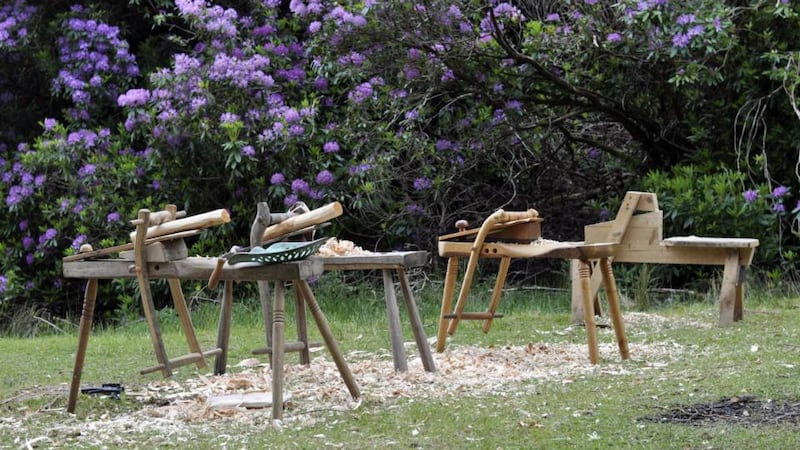Invented Tradition – Gareth Kennedy Galway Arts Centre ****
The editors of the book The Invention of Tradition, historians Eric Hobsbawm and Terence Ranger, argued that the concept of tradition as generally applied is problematic. Specifically, it can be used to validate ideological, political and cultural values and norms that would otherwise be open to question.
The notion is intriguing in relation to Irish history and current events, north and south. Apart from such well-documented inventions as Highland clan tartan patterns, Hobsbawm and Ranger had the whole edifice of nationalism and nations in their sights. In his essay, Hobsbawm detailed how various European nations “mass-produced” traditions in the crucial period 1870-1914, the better to foster national centres of gravity.

The line between real and invented tradition is, though, hard to draw. Gareth Kennedy doesn't exactly set out to do that in his exhibition Invented Tradition at the Galway Arts Centre, but the three projects that it includes all explore the historical and local context of specific traditions while looking to what Hobsbawm termed their "adaptability". That is, Kennedy modifies and applies them to the contemporary moment in various ways. He's also determined art will not be purely decorative or nostalgic or escapist but produce something useful.
He has a particular, enduring interest in what he terms "the social and cultural agency of handwork in the 21st century" and draws on specialist practitioners. As you make your way through the rooms of the arts centre, you'll encounter such manual skills and practices as charcoal- burning, wood-turning, boat-building, carpentry, construction and costume-making, all with a distinct twist or spin. In each case the end result, a kind of "folk fiction", should, he says, reflect and refer us to the "social, cultural and economic history of a people and a place". The most direct and straightforward piece is also the closest to Galway. Fan Nóiméad documents the realisation of a Galway County Council commission for Headford town. Kennedy worked with a group, Headford Men's Shed. The idea was that the shed members would work collectively to produce a structure for a public site in the town. Not just a decorative structure but a useful one with a social focus.
The men were working on making a currach with Connemara boat builder Patrick Connolly when Kennedy first contacted them. Struck by the good working relationship, he suggested that Connolly become involved. Collectively they devised a compact wooden pavilion, with seating, resembling a section of upturned hull. It is not an incidental resemblance; the shape, materials and methods were characteristic of the construction of the Galway hooker. Last August the pavilion was ceremoniously paraded through the streets during Headfest, installed, and launched by the Rose of Tralee, Maria Walsh.
A maze of meaning
Another project from last year, Post Colony, takes a more tangled path – inevitably, perhaps, since it ventures into a maze of Rhododendron x superponticum that has proved to be a dauntingly effective invasive species, not least in areas of Co Kerry. This time the project centred on a 10-day woodworking and charcoal-burning encampment, led by woodwright Eoin Donnelly, and utilising rhododendron wood, in the isolated setting of the ruin of Glena Cottage in Killarney National Park.
The 16mm film that describes the encampment also includes a kind of mock-ethnographic take on the history of the park, from plantation to deforestation (to build the fleet that built the British empire) to romanticised parkland, which is when rhododendrons, introduced as decorative shrubs, started to become an issue. In a nice aside, Kennedy illustrates how John Hinde, keen to have a bit of foreground colour in his postcards, used to insert chunks of freshly sawn rhododendron into the frame, doing wonders for the shrub's popularity. There are lots of ideas floating around here to do with natives and invaders in several senses, but the many parts never quite cohere into a convincing whole and the overall effect is diffuse.
Perhaps the most successful work is the one that was surely the most challenging for Kennedy. The Last Wooden House of Kupchino hinges on the story of the Nootskov family, who lived in the eponymous house, in a region of St Petersburg, until it was forcibly demolished in 1976 to make way for mass apartment blocks. Realising the family still commemorate the event annually, Kennedy had his starting point.
With carpentry students of Krasnoderevets College he made a half-scale model of the demolished house in emblematic birch, while local public school pupils made birch bark costumes based on characters from Russian fairytales. The model, hoisted aloft, was then, with costumed pupils and family members, paraded through the locality to the site of the original house. The St Petersburg curators point out that Super 8 film of the event and the scale model had significant afterlives in the locality.
Kennedy's grassroots practice is detailed and involving. With Sarah Browne he also sustains a collaborative partnership, as Kennedy Browne. Both have been industrious in delivering a non-stop succession of ambitious projects. If, on occasion, the research doesn't quite translate into resolved statement, they are still well ahead.
At the end of John Boorman's Leo the Last, an adaptation of George Tabori's play The Prince, a reformist landlord is taunted with the accusation he hasn't managed to change the world after all. "No," he responds, "but we changed our street." In a similar spirit, Kennedy and his peers seem to be taking it one street at a time.










